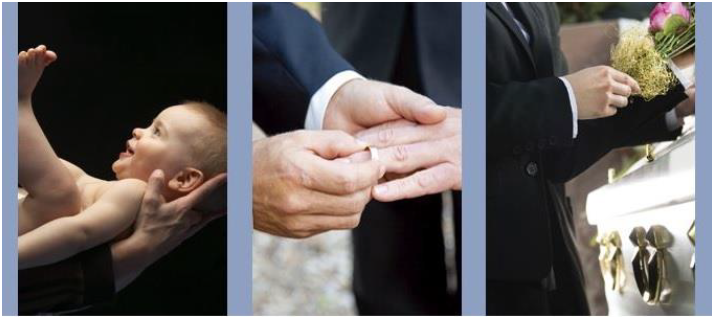Introduction to Irish Family & Social History, Week 2

Introduction
Civil records - births, marriages and deaths – are the easiest of all records to find and to interpret.
They’re the building blocks of your family history, often the first records you will use in research.
Key dates for civil registration
April 1845. Start of registration of non-Catholic marriages in Ireland. These marriage records account for approx. 30% of all marriages in Ireland, including inter-faith marriages where one party is Catholic.
January 1864 Civil registration starts of Births, Marriages and Deaths, for all people, of all denominations in Ireland.
1922 Partition created two jurisdictions on the island - the Irish Free State (later the Republic) and Northern Ireland – each with its own Civil Registrar.
The General Register Office of Ireland (GROI) has records of the Irish Republic; GRONI has records of Northern Ireland.
How to find the records
The civil register is available in hard-copy/ in Dublin (Werburgh St.) and Roscommon.
A hard-copy of the civil register of Northern Ireland, 1922 to the present, is in GRONI in Belfast.
Online
Civil records can also be found online.
Republic of Ireland: www.irishgenealogy.ie
Covers the entire island up to 1922, and thereafter is limited to the area of the Irish Republic.
Northern Ireland: https://geni.nidirect.gov.uk/
GRONI has births, marriages and deaths for the six counties (Antrim, Armagh, Down, Fermanagh, Tyrone, Londonderry), from 1864, and non-Catholic marriages from April 1845.
There is a cut-off point to preserve the privacy of living people.
What information will you find in the records?
Births contain the child’s date and place of birth; usually but not always the child’s forename; always the family name; the child’s gender; the father’s full name, trade or occupation, and dwelling-place; the mother’s full name including her maiden name; the signature and qualification of the informant; the date registered; the baptismal name if added after the registration (this last is rarely filled in).
Marriages have the date of the wedding, the bride and groom’s full names; Age – sometimes recorded as ‘full age’ i.e. over 21.
Where a bride or groom was under 21, they were supposed to enter their exact age in years in the register; marital condition – eg: bachelor, spinster, widowed; the bride and groom’s trade or occupation; their residence at the time of marriage; the bride and groom’s father’s names, his trade or occupation, and sometimes whether living or dead.
Look for the names of the witnesses – the best man and bridesmaid.
After 1956 Marriage records include the full maiden name of the bride and groom’s mothers, and the couple’s intended place of residence.
Deaths contain the least amount of information. They record the date and place of death; the deceased’s full name; their gender and marital status; the age of the deceased on their last birthday; their trade or occupation; the certified cause of death and duration of illness; signature, qualification and residence of the informant; date the death is registered.
Other records in the General Register Office
The annual volumes in Werburgh St. and Roscommon contain other registers, at the back of the bound volumes,
including:
• Late Registrations. Where registration took place more than twelve months after the event, a separate
short volume was bound at the back of the annual returns.
• Marine Register. Births, Marriages and Deaths at Sea 1886-1922.
• Army Births, Marriages and Deaths (Ireland), 1888 to 1930 for births, and to 1931 for marriages &
deaths.
• Boer War Deaths 1899-1902 – these are all bound in the back of the 1902 volume.
• WWI Deaths. These are very incomplete.
The GRO holds separate registers for other civil records, introduced into the system at a later date. Some of these records are sensitive and are not open to the public.
• Register of Lourdes Marriages (1950s to 1972).
• The Adopted Children’s Register, from 1952.
Nothing is recorded in the body of the record that could link the child being adopted to his/ her birth mother. The Register is a public record, but is held behind the counter, so you must ask to use it.
• Register of Still-births, from 1st Jany. 1995. Legislation allows for retrospective registration.
• Register of Civil Partnerships, 2010-16th Nov. 2015
The GRO also holds some older historic records.
• Schulze Marriages, 1806 to 1837. These are the earliest records of the Irish GRO. They record legal marriages that took place without banns or License.
• Irish subjects registered in a British Consul (1864-1921).
Checklist for using civil records
• Don’t rely on an index. Always look at the original document.
• Read your sources closely to get all the evidence
• Interpret the evidence, using deductive reasoning. For example, subtract a person’s age from their year
of death, to deduce their approximate year of birth. Be careful how you use the evidence, however. If
incorrect information is in the record, it can mis-direct you.
• Civil records are one link in your chain of evidence. Use the internal evidence in the document, to identify other relevant documents.
Visiting the General Register Office, Ireland
General Register Office,
Werburgh St.,
Dublin 2
General Register Office Northern Ireland (GRONI),
Colby House,
Stranmillis Court,
Belfast BT9 5RR
Read more
Irish Civil Registration: Where do I start, author Eileen M. O Duill, M.A. (Dublin, 2000)